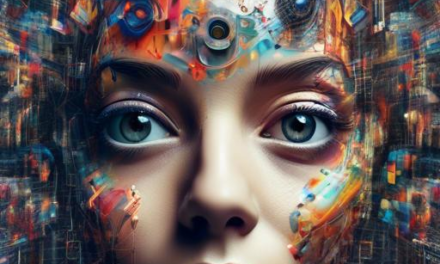As the digital brushstrokes of artificial intelligence continue to eke out landscapes and portraits with an almost eerie precision, society stands on the precipice of a new visual renaissance. These AI-driven imaginations, conjuring mesmerizing art at the click of a button, are not just redefining what is possible in the world of imagery but are also etching deep questions into the fabric of our ethical consciousness. While we awaken to the marvels of this technological odyssey, it becomes imperative to contemplate the compass that will guide us through the terrain of AI image generation. Welcome to an exploration of the future of ethics in this groundbreaking domain—a future where creativity and conscience must walk hand in hand, painting a world that is as just as it is innovative. Here, we weave through the potential, the pitfalls, and the principles that will shape the artistic horizon of tomorrow.
Table of Contents
- Ethical Imagery: Pioneering Principles for AI
- Transparency in Algorithms: Demystifying the Black Box
- Guardrails for Creativity: Avoiding Harmful Outputs
- Bias and Fairness: Striving for Inclusivity in Digital Art
- Cultural Sensitivity: Respecting Boundaries in Visual Content
- User Consent and Control: Empowering the Individual
- Policy and Regulation: Navigating the Legal Landscape
- Collaborative Frameworks: Engaging Diverse Stakeholders
- Education and Awareness: Building a Responsible Future
- Key Takeaways
Ethical Imagery: Pioneering Principles for AI
In the evolving landscape of AI, generating images through sophisticated algorithms is no longer a distant reality. However, the principles guiding this technological marvel need to be rooted in ethical considerations. The visual impact of AI-generated imagery can influence public perception significantly, making it crucial to build foundational ethical guidelines.
One of the primary tenets involves **transparency**. Users and viewers should be aware when they are consuming AI-generated content. This not only fosters trust but also educates the public on the capabilities and limitations of AI technologies. Clear labeling and disclosure can serve as a stepping stone towards moral clarity.
- **Transparency**: Clearly label AI-generated content
- **Bias Mitigation**: Ensure diverse and inclusive datasets
- **Purpose-Driven Design**: Align with beneficial outcomes
**Bias Mitigation** stands central to ethical imagery in AI. Historical data often comes with inherent biases that can propagate unfair stereotypes if not carefully curated. Diverse and inclusive datasets are essential to produce universally respectful and representative images. A commitment to this diversity helps avoid reinforcing negative prejudices and promotes inclusivity in AI applications.
| Principle | Description |
|---|---|
| Transparency | Labeling and disclosing AI content |
| Bias Mitigation | Using diverse datasets |
| Purpose-Driven Design | Focus on beneficial outcomes |
Another cornerstone is **purpose-driven design**. AI image generation should align with beneficial outcomes, such as enhancing creativity, aiding in medical imaging, or supporting educational tools. Ethical use cases ensure the technology serves humanity positively rather than facilitating harmful or deceptive practices.
By embedding these pioneering principles into the fabric of AI development, we steer towards a future where innovation walks hand in hand with responsibility. As creators and consumers, championing these ethical guidelines not only advances technology but also safeguards societal values.
Transparency in Algorithms: Demystifying the Black Box
Imagine a world where every step an algorithm takes is as clear as crystal water. This is not just a utopian dream but a necessity for **ethical AI image generation**. Lack of transparency can lead to unintentional biases, manipulation, and a host of issues that undermine user trust and the integrity of AI systems. To ensure accountability, it is crucial to make these complex algorithms understandable and transparent to both developers and users.
**How can we achieve this transparency?**
- **Open-source frameworks**: Encouraging the use of open-source coding allows for wider scrutiny and improvement.
– **Explainable AI (XAI)**: Developing techniques that offer insights into how algorithms arrive at certain decisions.
– **Regular audits**: Conducting frequent, systematic audits to identify biases or errors.
- Guidelines for Ethical Use: Establishing clear guidelines and ethical standards for AI image generation can provide a roadmap for responsible development.
- Stakeholder Involvement: Involving diverse groups, including ethicists, developers, and affected communities, can ensure a balanced approach.
- Educational Initiatives: Promoting AI literacy to demystify complex systems for the general public.
One practical approach is using a transparency index to rate and compare different AI models. Below is an example of what such an index might look like for various AI image generation tools:
| AI Tool | Transparency Rating | Strengths | Weaknesses |
|---|---|---|---|
| Tool A | High | Open-source, detailed documentation | Complex for beginners |
| Tool B | Medium | User-friendly, real-time explanations | Limited customization |
| Tool C | Low | Fast processing | Opaque algorithm |
By adopting these strategies, we can foster a more transparent and trustworthy ecosystem for AI image generation, ensuring that innovation goes hand in hand with ethics. Together, we can lift the veil on the “black box” and enable more inclusive, fair, and transparent AI technologies.
Guardrails for Creativity: Avoiding Harmful Outputs
Artificial intelligence holds remarkable potential in image generation, yet with great power comes great responsibility. Developers must implement rigorous **guardrails** to ensure outputs do not cause harm or perpetuate negativity. Fostering a safe and constructive creative environment demands proactive measures.
- Training on Diverse Datasets: One essential approach is diversifying the datasets used in training AI models. By encompassing a wide variety of cultural, social, and historical contexts, these systems can produce images that are more representative and inclusive.
- Bias Detection Tools: Implementing automated tools to detect and mitigate biases ensures fairness. These tools analyze outputs for unintended skewing, correcting any deviations to maintain ethical standards.
- User-Controlled Filters: Empowering users with control over the AI’s parameters allows them to avoid generating content that may be disturbing or offensive. Filters for certain themes can prevent harmful outputs.
Additionally, transparency and accountability are paramount. AI developers should maintain open communication channels, providing users with insights into how image generation models are trained and the kinds of safeguards in place. This fosters trust and encourages responsible usage.
| Guardrail | Benefit |
|---|---|
| Diverse Datasets | Reduces bias, promotes inclusivity |
| Bias Detection Tools | Identifies and corrects skewed outputs |
| User-Controlled Filters | Prevents harmful content generation |
continuous **feedback loops** between the developers, users, and the wider community serve as a crucial element. These loops ensure that any arising issues are swiftly addressed and that the innovation in AI image generation remains ethical and progressive.
Bias and Fairness: Striving for Inclusivity in Digital Art
Digital art, much like any other creative expression, is a reflection of the world around us. However, as artificial intelligence takes a more prominent role in generating images, the risk of **bias** in these creations becomes a substantial concern. Ensuring fairness in AI-generated art is critical to fostering a sense of inclusivity and respect for all cultures and identities.
Among the measures to mitigate bias, **diverse training datasets** stand out. If an AI is only exposed to a narrow set of images or artistic styles, its outputs will inevitably lean towards those influences, neglecting other important perspectives. To counter this:
- Curate datasets from various cultural and ethnic backgrounds
- Include art forms from both mainstream and underrepresented communities
- Regularly update datasets to reflect current and evolving artistic trends
Transparency in the development process of AI systems also plays a crucial role. Knowing the sources of the data and the methodologies used in training enables more informed critique and continuous improvement. Implementing **ethical guidelines** and collaborating with a diverse group of stakeholders can help ensure more balanced and inclusive outputs.
| Aspect | Action |
|---|---|
| Data Collection | Ensure diversity and inclusivity |
| Transparency | Document sources and methodologies |
| Stakeholder Collaboration | Engage diverse voices in development |
Moreover, **ongoing monitoring** and **audits** of AI outputs can help identify and address any unintentional biases. By setting up review mechanisms, we can catch potential issues early on and adapt the algorithms accordingly.
Ultimately, achieving fairness in AI image generation isn’t an end point but a continuous journey. Commitment from both developers and the artistic community is key to creating a more inclusive and representative digital art landscape that celebrates the richness of human creativity.
Cultural Sensitivity: Respecting Boundaries in Visual Content
The delicate balance of cultural sensitivity in AI image generation is an area that demands significant attention. As AI creators, understanding cultural nuances and respecting boundaries is crucial to preventing the inadvertent propagation of stereotypes or the misappropriation of cultural symbols.
One major aspect to consider is the **representation of diverse cultures**. AI models trained on biased datasets can easily misrepresent or overlook entire communities. Here are some principles for ensuring respectful and accurate representation:
- Diverse Datasets: Leverage datasets that represent a wide array of cultures, ensuring inclusivity.
- Cultural Consultation: Collaborate with cultural experts to guide the design process and validate outputs.
- Continuous Monitoring: Regularly update and audit AI systems to eliminate potential biases.
Another potent issue is the **misappropriation of cultural symbols**, such as traditional attire, religious items, and indigenous artifacts. Using these symbols incorrectly can lead to significant cultural insensitivity and backlash. It is vital to impose strong **ethical guidelines** on their use:
- Informed Consent: Explicitly obtain permissions from cultural communities before using their symbols.
- Contextual Accuracy: Ensure symbols are used in appropriate and contextually accurate ways.
- Respect for Sacred Items: Exclude sacred or culturally significant items from general usage without explicit approval.
it is essential to **empower diverse voices** in the development process. This involves active inclusion of culturally diverse perspectives in AI teams. It’s important to:
- Promote Diversity: Employ team members from varied cultural backgrounds to enrich the development process.
- Inclusive Feedback Loops: Incorporate feedback from a wide range of users to identify and rectify cultural inaccuracies.
- Educational Initiatives: Implement training programs to raise awareness about cultural sensitivity within your team.
By embedding these practices, the future of AI image generation can be more ethical, culturally sensitive, and respectful of the diverse tapestry of human cultures.
User Consent and Control: Empowering the Individual
In an era where artificial intelligence reshapes how we create and consume images, **user consent** and **individual control** emerge as paramount ethical considerations. Providing individuals with the tools to understand and govern the use of their personal data is not just an ethical imperative but a step towards empowering the individual in this rapidly evolving landscape.
**Key Areas of User Empowerment:**
- Transparent Data Usage: Users should be clearly informed about how their data is collected, stored, and used. This includes a comprehensive understanding of the types of data being utilized to train AI models.
- Granular Controls: Allowing users to set specific permissions for different types of data can enable a more personalized and comfortable experience. For example, a user might be willing to share general images but not personal portraits.
- Revocation Rights: Users must have the ability to withdraw consent at any stage, with the assurance that their data will be completely erased from all databases and AI models.
Imagine a platform where users can directly manage their contributions to AI training. This can be visualized through a simple interface:
| User Action | Control | Benefit |
|---|---|---|
| Upload Image | Select shared data types | Personalized data contribution |
| View Usage Report | Detailed data insights | Informed consent and transparency |
| Revoke Consent | Immediate data removal | Enhanced privacy control |
Furthermore, embedding **ethical AI practices** involves community input. By integrating feedback loops where users can express concerns or suggestions, AI systems can evolve in ways that prioritize the community’s voice. This approach not only builds trust but also ensures that AI advancements align with societal values.
As we venture into the future of AI-powered image generation, building frameworks that respect and uplift user autonomy will be crucial. Facilitating mechanisms for consent, providing transparent usage insights, and prioritizing control will pave the way for a more ethically sound and user-centric AI ecosystem.
Policy and Regulation: Navigating the Legal Landscape
Navigating the intricate **legal landscape** of AI image generation is akin to traversing through a maze with evolving walls. It’s not just about understanding current laws but anticipating future regulations and their implications. Policymakers and regulatory bodies are racing to keep pace with the rapid advancements in AI technology, striving to balance innovation with ethical standards.
One of the most pressing issues is **intellectual property (IP)**. Who owns an AI-generated image? Is it the creator of the algorithm, the user generating the image, or the AI itself? These questions spark debates that challenge traditional IP laws, urging legislators to rethink and redefine ownership in the context of machine-generated art. As businesses and individuals increasingly utilize AI for creative processes, the demand for clear and fair IP frameworks becomes paramount.
**Privacy concerns** also come to the fore. With the ability of AI to assimilate and reproduce likenesses and personal data, stringent measures are essential to protect individual privacy. Regulatory frameworks must ensure that AI systems adhere to data protection standards, providing transparency about data usage and securing explicit consent from those whose images might be used. The responsibility lies with developers and users alike to adopt ethical practices that safeguard personal information.
Furthermore, the **ethical usage** of AI-generated images implicates several social concerns. Misinformation through deepfakes, manipulation of media, and the creation of inappropriate content demand stringent policies. Legislations need to mandate clear guidelines on the permissible uses of AI-generated images and establish robust mechanisms to monitor and penalize misuse. Educational campaigns about the ethical implications of AI technologies could also help in building a more informed and responsible user base.
Consider the following table summarizing current policy focus areas:
| Focus Area | Description |
|---|---|
| Intellectual Property | Redefining ownership laws for AI-generated content. |
| Privacy Protection | Ensuring data security and transparent usage practices. |
| Ethical Guidelines | Preventing misuse and promoting responsible use of AI. |
| Monitoring and Enforcement | Creating and implementing mechanisms to oversee AI deployment. |
Collaborative Frameworks: Engaging Diverse Stakeholders
To effectively address ethical concerns in AI image generation, the integration of diverse perspectives is paramount. Collaborative frameworks involving various stakeholders can promote a balanced approach to ethics. **By including voices from different sectors**, such as technology developers, ethicists, legal experts, and the wider public, we can create a holistic understanding and formulation of ethical guidelines.
- **Tech Developers:** Insight on algorithm intricacies and potential biases.
- **Ethicists:** Guidance on moral principles and values.
- **Legal Experts:** Knowledge of current laws and potential legal ramifications.
- **Public Input:** Concerns and expectations from a societal perspective.
Engaging these stakeholders requires structured dialogue platforms. Roundtable discussions, public forums, and online surveys provide opportunities for meaningful interaction. Such frameworks not only democratize the decision-making process but also ensure that ethical standards evolve in parallel with advancements in AI technologies.
| Stakeholder | Role |
|---|---|
| Technology Developers | Offer technical insights and highlight innovations |
| Ethicists | Ensure alignment with moral principles |
| Legal Experts | Assess compliance with legal standards |
| Public | Express collective values and concerns |
Moreover, **policy creation must be an iterative process**. Regular review and updates based on stakeholder feedback can address emerging ethical dilemmas. This dynamic approach allows for continuous improvement and adaptation to new challenges in AI image generation.
Education and Awareness: Building a Responsible Future
As we forge ahead in the incredible journey of AI and image generation, it’s crucial to remain vigilant about the ethical implications. This means cultivating a culture of **education and awareness**, ensuring that everyone—from developers to end-users—understands their role in maintaining ethical standards.
High-level education programs and grassroots awareness initiatives can help illuminate the potential pitfalls and extraordinary possibilities of AI-generated imagery. **Workshop and seminar topics** might include:
- Understanding Bias in AI Models
- Implementing Ethical Guidelines in AI Development
- The Consequences of Misinformation and Deepfakes
- Promoting Transparency in AI Processes
| Educational Resource | Description |
|---|---|
| Online Courses | Flexible learning modules about AI ethics. |
| Workshops | Hands-on training on ethical AI practices. |
| Webinars | Expert talks on current ethical issues in AI. |
**Transparency and accountability** should be at the core of every educational effort. By openly sharing successes and setbacks, we can collectively learn and improve our ethical frameworks. This can be fostered through **community forums**, where passionate individuals discuss challenges and brainstorm solutions. Engaged participation in these forums can drive a positive feedback loop, nurturing a responsibly evolving AI landscape.
Moreover, industry collaborations can significantly magnify the impact. By joining forces with tech companies, educational institutions, and regulatory bodies, we can develop **comprehensive ethical guidelines** that are both robust and adaptable. Such unified efforts ensure that as we stride towards the future, we do so with a conscience as clear as our technological vision.
Key Takeaways
As we continue to navigate the ever-evolving landscape of AI image generation, it is crucial that we prioritize ethical considerations to ensure that innovation is met with responsibility and accountability. By fostering ongoing dialogue, collaboration, and critical reflection, we can shape a future where AI technology is harnessed for the greater good of humankind. Let us embark on this journey with an unwavering commitment to ethics, integrity, and compassion, paving the way for a future where AI image generation not only captivates us with its creativity, but also uplifts our collective humanity. Together, let us embrace the limitless potential of AI technology while staying rooted in our shared values and principles. The future of ethics in AI image generation is in our hands - let us rise to the challenge and build a future we can all be proud of.
































